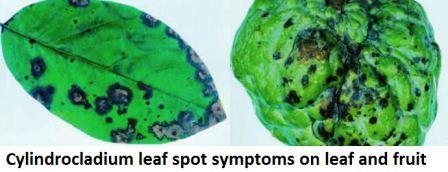Custard Apple Diseases
Custard Apple Diseases
Anthracnose
Disease symptoms- Infection begins at blossom-end of the fruit and later spreads on entire fruit surface, affected fruits shrivel and they may cling to the tree or fall down.
- Necrotic spots of 2-10 mm in diameter appear on unripe fruits which turn into dark brown to black spots. These spots coalesce later and cover entire fruit.

- Wet and windy conditions favour the disease
- Older fruits left on the trees provide inoculum for disease spread.
Leaf spot
Disease symptoms- Alternaria leaf spot: Small yellowish spots first appear along the leaf margins, which gradually enlarge and turn into brownish patches with concentric rings. Severe infection leads to drying and defoliation. Dark brown-purplish patches appear on the infected fruits andrachis just below its attachment with the shoots.
- Cylindrocladium leaf spot: Upper: dark purple spots about 1 to 2 mm in diameter develop first on the shoulders of the fruit and then spread down the sides. Spots enlarge and then later dry out and crack. Similar in appearance to spotting bug damage, but spots are irregular in shape whereas spotting bug lesions are round, and damage does not extend very far into the fruit.

- The pathogen survives through spores (conidia) or mycelium in diseased plant debris or other hosts.
- Relative humidity above 70% coupled with warm weather (12-25 ºC temp.) and intermittent rains favours disease.
Diplodia rot
Disease symptoms- Diseased fruits show symptoms of purplish to black spots or blotches confined to the surface of the fruit and eventually covered with white mycelia and black pycnidia.
- Diplodia rot is distinguished by its dark internal discolouration and the extensive corky rotting produces.
- The penetrated flesh eventually softens or hardens and cracks, depending on the presence of secondary microbes.

- Optimum temperature is 25.9°C to 31.5°C and relative humidity is 80%
- The pathogen persists in infected plant parts which serve as source of inoculums.
Black canker
Disease symptoms- Irregularly shaped spots ranging from small specks to large blotches.
- Spots have an indistinct ‘feathered’ edge.
- Tissue damage under the spots is no more than 10 mm deep.

- The disease is favored by extremely wet weather and cool-to-moderate temperatures (15ºC to 20ºC). When prolonged rainy periods exist in the spring and provide at least six hours of continuous wetness
- The pathogen persists in infected plant parts which serve as source of inoculums.
Spiral nematode and Stunt nematode
Life cycle- Nematodes molt four times during each life cycle with a molt occurring at the end of each larval stage.
- Therefore, molts separate the first and second larval stages, the second and third larval stages, the third and fourth larval stages, and also the fourth larval stages and immature adults.
- The 5th stage larva grows to the limit of its new cuticle, at the same time developing into a sexually mature adult male or female.
IPM for Custard Apple
To know the IPM practices for Custard Apple, click here.
Source: NIPHM, Directorate of Plant Protection, Quarantine & Storage
Last Modified : 2/13/2020
© C–DAC.All content appearing on the vikaspedia portal is through collaborative effort of vikaspedia and its partners.We encourage you to use and share the content in a respectful and fair manner. Please leave all source links intact and adhere to applicable copyright and intellectual property guidelines and laws.
RELATED ITEMS
Curryleaf Pests and Diseases
This topic provides information about Curryleaf Pe...
Fig Diseases
This topic covers information about Fig Diseases.
Ginger: Diseases and Symptoms
This topic covers the Information related to Disea...
Ber Diseases
This topic covers information about Ber Diseases.
